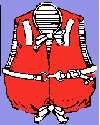Personal Flotation Devices (PFDs)
Fit and Size
Proper size is important when selecting a PFD. A PFD that is too small may not keep you afloat, and one that is too large may fall off on impact if you were suddenly thrown into the water.
PFDs should be snug around the torso. When lifting on the shoulder straps, they should not come past the bottom of the ears. PFDs are sized by weight and chest size. Try on a PFD before purchasing it to assure a proper fit.
Types of PFDs
Personal flotation devices (PFDs), or life jackets, come in several types and styles. Refer to the US Coast Guard label on the inside of each PFD for instructions and allowable use requirements for each PFD type.
Type I – Off-Shore Life Jacket

Type I PFDs are best for open, rough, or remote water where rescue may be slow in coming.
- Minimum Buoyancy
- Adult: 22 lbs.
- Advantages
-
Floats you best; Turns most unconcious wearers face-up in the water; Highly visible color.
- Disadvantages
-
Bulky
Type II – Near-Shore Buoyant Vest

Good for calm, inland water, or where there is good chance of fast rescue.
- Minimum Buoyancy
- Adult: 15.5 lbs.
- Advantages
-
Turns some unconscious wearers face-up in water. Less bulky, more comfortable than Type I PFD. Inexpensive.
- Disadvantages
-
Not for long hours in the water. Will not turn some unconscious wearers face-up in water.
Type III – Flotation Aid

Good for calm, inland water, or where there is good chance of fast rescue.
- Minimum Buoyancy
- Adult: 15.5 lbs.
- Advantages
-
Generally the most comfortable Type for continuous wear. Freedom of movement for many active water sports. Available in many styles.
- Disadvantages
-
Wearer may have to tilt head back to avoid going face-down. In rough water, a wearer's face may often be covered by waves. Not for extended survival in rough water.
Type IV – Throwable Device

For calm, inland water with heavy boat traffic, where help is always nearby.
- Advantages
-
Can be thrown to someone. Good back-up to wearable PFDs. Some can be used as a seat cushion.
- Disadvantages
-
Not for unconscious persons. Not for non-swimmers or children. Not for many hours in rough water.
Type V – Hybrid Device

Required to be worn to be counted as a regulation PFD.
- Advantages
-
Least bulky of all Types. High flotation when inflated. Good for continuous wear.
- Disadvantages
-
May not adequately float some wearers unless partially inflated. Requires active use and care of inflation chamber.